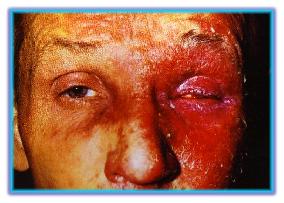| Numerous environmental
and externally applied agents, including a host of facial
cosmetics and topical ophthalmic preparations, can affect
the eyelids. Development
of acute irritation , erythema, swelling and dry or wet
scaling (eczema) of the skin around the lids, in
association with application of a preparation to the
periocular facial skin or the eye, suggests cell-mediated
type IV hypersensitivity reaction.
The agents most commonly
associated with this immune reaction are sensitizing
antibiotics (such as neomycin.) Atropine is another
common causative agent.
If the inflammatory
response is severe, treatment involves discontinuing the
use of the offending agent and, occasionally, applying a
topical corticosteroid ointment. However, if secondary
bacterial infection is present, a topical corticosteroid
is contraindicated.
|
 |

